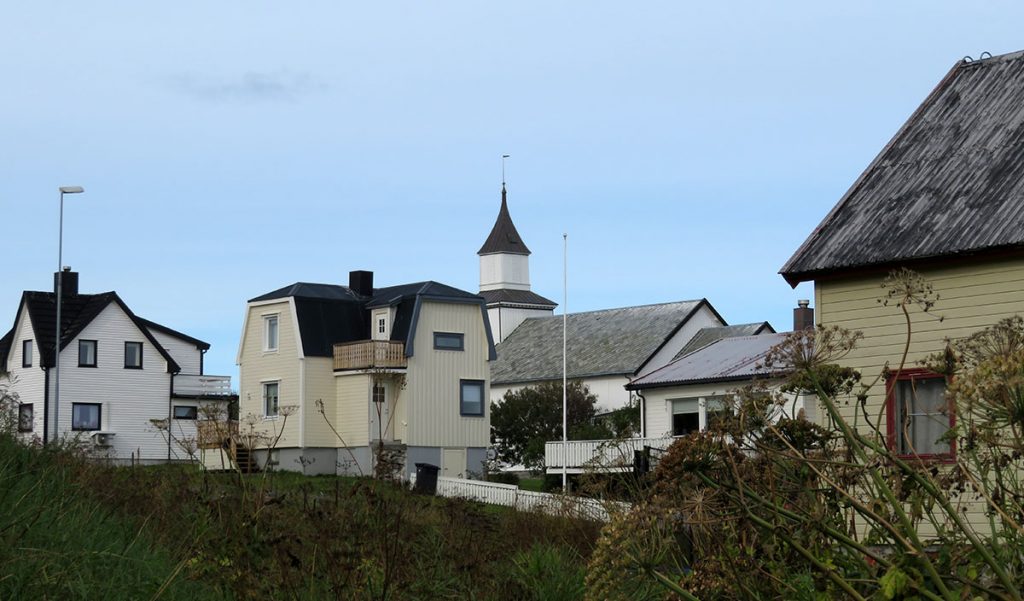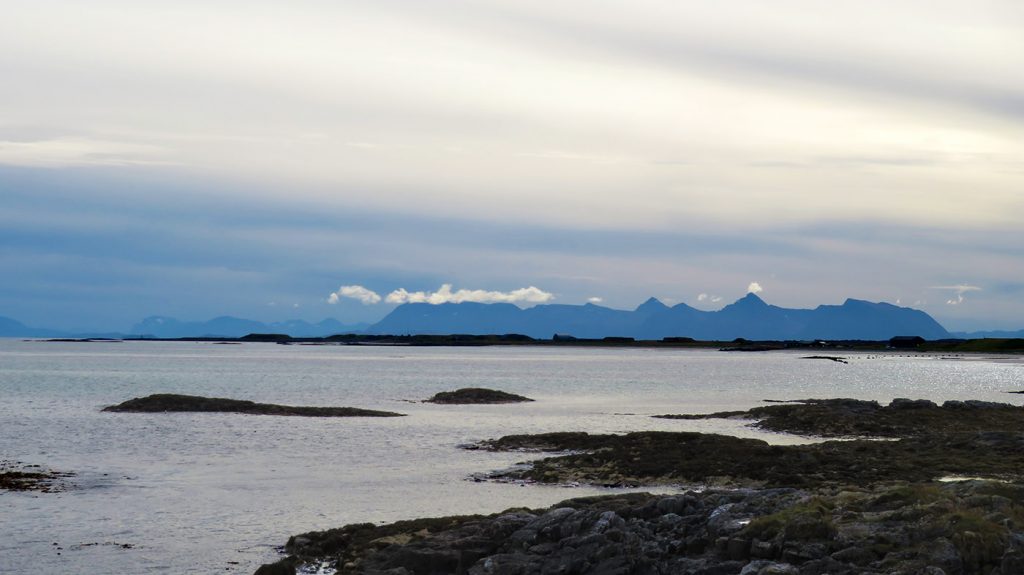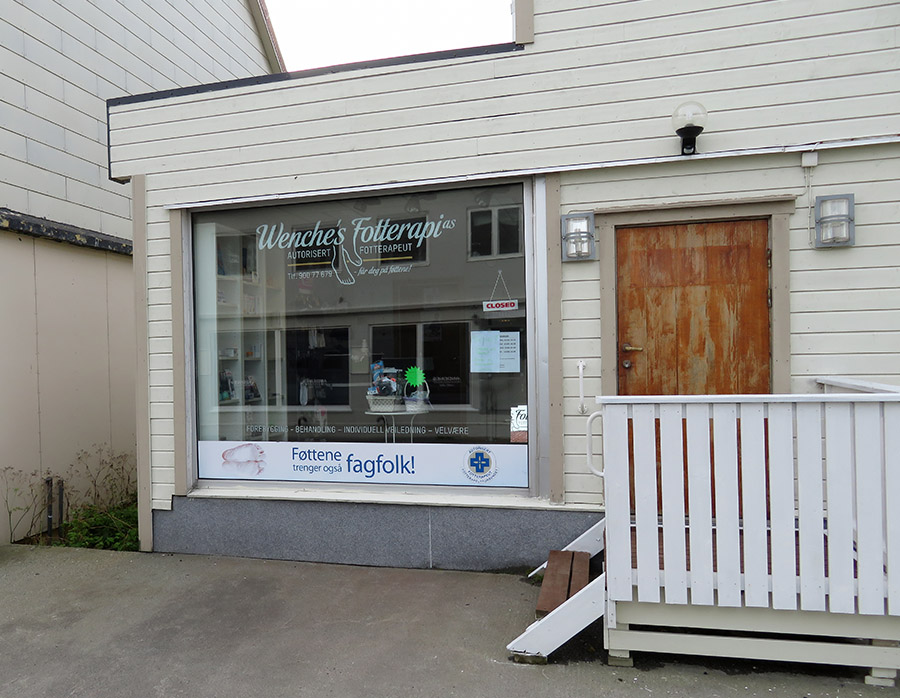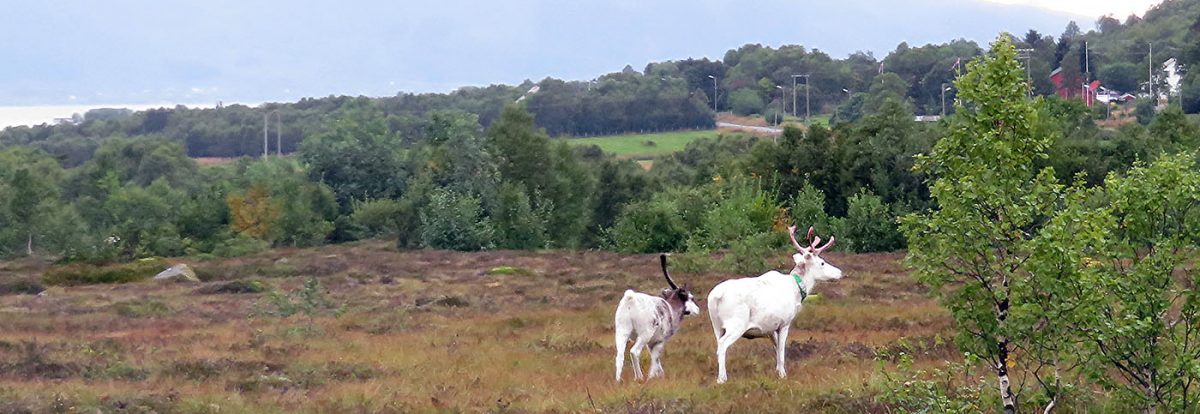La versión español está después de la versión inglés.
WELL, THE TITLE is a bit of a stretch, especially if you speak Spanish. I’m referring to reindeer, of course. The play on words works in English — rain and rein, and dear and deer. However, rain in Spanish is lluvia and reindeer in Spanish is ciervo. Oh, and dear is querido. So, I suppose, it’s not just a stretch; it simply makes no sense.
Anyway… Have you ever noticed how often I begin a sentence with “Anyway”?
ANYWAY, I had thought this would be my final blog post about our recent trip to Norway. But, as I made another pass through my photos I realized I have a few more stories to tell. So, I hope you’re enjoying Norway because you haven’t seen the last of it.
ONE DAY, WE DROVE ABOUT 100 km north from Sortland to Andenes, which is 50km north of Bjørnskinn, where San Geraldo’s grandfather was born. Andenes, with a population of around 2,700, is the northernmost settlement on the island of Andøyo and about 460 km north of the Arctic Circle. Some of the views across the vast emptiness of sea and mountains are breathtaking. But there’s not much to see in the town itself. Some great boat trips — whales, sealife, birds — but we’ll have to plan for that next time. Reservations and warm clothing are good ideas. San Geraldo did some research at the public library, while I wandered. In the rain, dear.
.
BUENO, EL TÍTULO es un poco exagerado, especialmente si hablas español. Me refiero a los renos. El juego de palabras funciona en inglés: rain y rein[deer]. Sin embargo, rain en español es lluvia y reindeer en español es ciervo. Ah, y dear es querido. No suenan para nada iguales. Entonces, supongo, no es solo exagerado; simplemente no tiene sentido. ¿Me entiendes?
De todos modos … ¿Alguna vez has notado con qué frecuencia comienzo una oración con “De todos modos”?
DE TODOS MODOS, pensé que esta sería mi última publicación de blog sobre nuestro viaje reciente a Noruega. Pero, cuando hice otro pase por mis fotos, me di cuenta de que tenía algunas historias más que contar. Entonces, espero que estés disfrutando de Noruega porque no has visto lo último.
UN DÍA, CONDUCIMOS UNOS 100 km al norte de Sortland a Andenes, que está a 50 km al norte de Bjørnskinn, donde nació el abuelo de San Geraldo. Andenes, con una población de alrededor de 2.700, es el asentamiento más septentrional de la isla de Andøyo, a unos 460 km al norte del Círculo Polar Ártico. Algunas de las vistas a través del vasto vacío del mar y las montañas son impresionantes. Pero no hay mucho que ver en la ciudad misma. Algunos excelentes viajes en bote: ballenas, vida marina, aves; pero tendremos que planear eso la próxima vez. Las reservas y la ropa abrigada son buenas ideas. San Geraldo investigó un poco en la biblioteca pública, mientras yo deambulaba. En la lluvia, querido.

Construida en 1843, iglesia octogonal en el pueblo de Dverberg. A medio camino entre Bjørnskinn y Andenes. Todavía bajo un cielo azul.

Biblioteca Pública de Andenes. Construido sobre lo que fue un refugio antiaéreo de la Segunda Guerra Mundial.


Buscando en el antiguo refugio antiaéreo.

San Geraldo leyendo sobre su tataratío Helmer Hanssen (abajo a la izquierda), explorador polar, navegante, y conductor de trineos tirados por perros con Roald Amundsen en la primera expedición exitosa al Polo Sur en 1911. La pareja parcialmente visible en la página son los tatarabuelos.




Pasé por esta oficina de “terapia de pies” en Andenes mostrando la palabra “fagfolk”. En inglés, “fag” es una mala palabra para una persona gay. Desde entonces he aprendido que “fagfolk” significa “profesionales”. ¡Fagfolk, y orgulloso de ello!

En el camino de regreso a Sortland, Andøy Friluftssenter (Centro de Recreación), donde San Geraldo tenía pastel de alce y yo trucha alpina (haz clic aquí). Esto solo vale un viaje al norte,


Haz clic aquí para descubrir lo que pensábamos que Friluftssenter significaba cuando pasamos hace dos años.

Una lámpara de pared con cabeza de alce (tamaño de una cabeza de alce real). Vimos esto en dos restaurantes y decidimos que teníamos que tener uno para la terraza. Lo encontré en línea por €1.400, lo que nos hizo darnos cuenta de que nuestros techos no son lo suficientemente altos.

A punto de salir de Friluftssenter.

Más lluvia, querido.


I’m loving this tour of Norway. Keep ’em coming, please!
Susan:
Not a lot more… Amazingly, I’m almost through anything worth sharing. A couple of side stories, I think.
“fagfolk” – LOVE IT!
anne marie:
The singing duo Romanovsky & Phillips liked to refer to themselves as Professional Homosexuals. In Norwegian that would be Fagfolk Homoseksuell. I like it!
Amazing book and connection to history, looks like a great adventure.
David:
Norway has a series of what are called “bygdebok,” which are history books that cover the local parishes and every family that ever lived there. An amazing resource and a genealogist’s dream. And Helmer Hanssen is a big name in the country.
“Which made us realize our ceilings aren’t tall enough”
Ha!!!!!!!!
p.s. I love the San Geraldo family history connection!
Judy:
$1,600 for a moose head sconce that serves no practical purpose. If only it would fit… ahem. Traveling is so much more interesting to me given Jerry’s fascinating genealogy. There seems to be a connection everywhere we go that makes the history more real.
Mitch, you must have been a grammar/literature teacher’s dream! You are so smart with words. Good teachers or one/both of your parents?
This part of Norway looks very isolated and sparse indeed……with the essentials. Must be very desolite in the winter.
Great photos.
Jim:
Aw, thanks! I was an English minor, but I’ve always loved to play with words. I can’t imagine living up north in winter… although we’re thinking our next trip should be in winter so we can experience the Northern lights.
I have never seen white reindeer! How beautiful they are. I hope someday to see a moose in person.
Mistress Maddie:
We were told by family there that all-white reindeer are very rare. So even more special for us to see it. The last time we were in Northern Norway, we saw moose on every drive we took, sometimes strolling across the road right in front of us. This time, we didn’t see one. They are spectacular.
Anyway …. love a good play on words, even if the play doesn’t exactly translate!
Bob:
Since I’m always playing with words, it makes my blog a bit more challenging for me. I don’t play as much since it usually makes no sense in Spanish. And when I do play I have to explain it in Spanish!
Ruggedly beautiful landscape and interesting architecture in that small place!
Debra:
I should have taken more photos of the town itself. It’s mostly residential, small, simple homes. Looks almost like a stripped down beach town in style. Not a lot there. But a boat trip would be amazing.
I took a taxidermy course many years ago. The instructor said he had a houseful of other people’s moose heads and geese on-on-the-wing mounts. Once people get them home, the ceiling isn’t high enough. But I bet none of them lit-up! I did what we affectionately called the “road-kill rabbit”. Very hard to do mammals.
Ann(Cheech?):
We had a collection of dead animals for a while. It started with a pheasant shot by Jerry’s brother-in-law in South Dakota and mounted for him as a Christmas present. Then there was a rattle snake, a banty rooster, a wood duck, and a Canada goose on the wing (our ceilings were high enough). I finally told Jerry we had enough dead animals. They went as we down-sized.
Gorgeous! Enough about SG, the scenery is gorgeous too.
Deedles:
Sometimes, SG is all the scenery I need.
Hear, hear!
The word ‘anyway’ always makes me smile for Monty Python would often change sketches with a brief interruption of someone (usually a Viking) saying “anyway” and off to a new scene.
Urspo:
I wonder if I picked it up from Monty Python or if it’s something I always did. I also like to start conversations with SO; which I used to think was kind of a NYC thing.
So – is the first word in Boewolf
Urspo:
See? I’m just ultra-literary … and ultra-sketchcomedyerary.
Do Not Stop with the Norway stories and photos. Love the sod/grass growing on the roof.
How exciting the history of San Geraldo family.
parsnip
Parsnip:
Those sod roofs are so common and so charming. We have cousins with old family cabins like that, too. I think I might soon run out of Norway. Time to go back!
I can’t remember exactly how it goes but there’s a joke about a husband and wife and communist expert on precipitation named Rudolph that ends with, “Rudolph the Red knows rain, dear.”
Kirk: I had forgotten that joke until you mentioned it… Here’s a good version:
Moscow Red Square in Winter
An American couple was being shown around Moscow one day, when the man felt a drop hit his nose.
“I think it’s raining,” he said to his wife.
“No, that felt more like snow to me,” she replied.
“No, I’m sure it was just rain,” he said.
Well, as these things go, they were about to have a major argument about whether it was raining or snowing.
“Let’s not fight about it!” the man said. “Let’s ask our guide, Rudolph, whether it’s officially raining or snowing.”
As their tour guide approached, the man said, “Tell us, Comrade Rudolph, is it officially raining or snowing?”
“It’s raining, of course,” he replied officiously.
But the woman insisted, “I know that it felt like snow!”
The man quietly replied, “Rudolph, the Red, knows rain, dear!“
You can never bore us with your travel photos. Or the cats. 🙂
Walt the Fourth:
I’m running low (I think) on Norway photos and even New York photos but the cats, never… Thanks for your tolerance!
Very good / Muy bueno.
The distance between Arctic Circle and Nuorgam is 446 km. This is how it looks like:
Nuorgam, the northernmost village of Finland and the European Union.
Tenga un buen día!